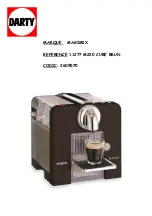
11
• Pour the frothed milk slowly over the coffee with the
aid of a spoon, then sprinkle a bit of cocoa powder
on top for a perfect cappuccino.
• To make four cappuccinos, repeat the previous
steps, paying attention to the quantity of water, milk
and ground coffee indicated in the table at the end
of the instructions. Before positioning the Vario
System selector in the Cappuccino position, let the
coffee drip into the carafe until it reaches level 4 on
the COFFEE LEVEL side (as shown in Figure 30).
IMPORTANT:
The cappuccino maker must always be
cleaned after each use. Proceed as follows:
• Remove the cappuccino maker by turning it
clockwise (Fig. 31) and wash it thoroughly with
warm water.
• Check that the three holes indicated in Fig. 32 are
not obstructed. Clean if necessary using a pin.
• Clean the steam spout, being careful not to burn
yourself.
• Screw the cappuccino maker back on.
CLEANING AND MAINTENANCE
• Before carrying out any cleaning operations, let the
appliance cool down and unplug it from the mains
outlet.
• Never immerse the coffee maker in water: it is an
electrical appliance.
• Do not use solvents or abrasive detergents to clean
the appliance. A soft damp cloth is sufficient.
• Clean the filter-holder, drip tray, boiler outlet,
carafe and water tank regularly. Never wash the
filter-holder in the dishwasher.
• Rinse all the components and clean the metal filter
thoroughly with warm water and a small brush
(Fig. 33).
• From time to time, check to make sure the holes in
the espresso coffee filter are not obstructed. If
necessary, clean using a pin (see Fig. 34).
• Check the Flavor Savor periodically, removing it
from the filter-holder cone by pulling it upwards
(Fig. 35). Clean it thoroughly and replace.
DESCALING THE ESPRESSO/CAPPUCCINO
SECTION
Over time, heating the water used to make the coffee
leads to lime scale buildup in the internal circuits of the
appliance.
We therefore recommend that you descale the espresso
maker every 2-6 months (depending on the hardness
of the water and the frequency of use).
Proceed as follows:
1. Fill the small carafe with water up to level 4 on the
WATER LEVEL side.
2. Dissolve 1 spoonful (about 15-20 grams) of citric
acid (sold at drugstores) in the water.
3. Pour the solution into the boiler and screw on the
cap.
4. Make sure the steam knob is closed and attach the
filter-holder.
5. Place the carafe under the espresso filter-holder.
6. Turn the Vario System selector to LIGHT and turn the
coffee maker on.
7. After a few minutes, the solution begins to run into
the carafe.
Every now and then, turn the steam knob to let out
a little of the solution from the cappuccino maker.
8. When all the solution has run through, turn the
appliance off and let it cool down.
9. To eliminate the descaling solution residues, repeat
steps 1 to 8 at least twice, using water only (without
adding citric acid).
DESCALING THE DRIP COFFEE SECTION
Over time, the lime contained in the water will cause
blockage that can prevent the machine from working
properly.
The coffee machine is equipped with a system for
controlling the amount of lime.
When the lime reaches a high level, the drip coffee ON
light begins to flash: this means it is time to descale.
To descale, proceed as follows:
1. Fill the carafe with clean cold water up to the 4 cup
level.
2. Dissolve 2 spoonfuls (about 30 grams) of citric acid
(sold at drugstores) in the water.
3. Pour the solution into the water tank and place it in
the machine.
4. Remove the filter from the filter-holder (to avoid
contamination).
5. Place the carafe with the lid on the warming plate.
6. Press the DRIP COFFEE ON/OFF button and let
one cup of solution run into the carafe; then turn off
the machine.
7. Leave the solution to work for one hour.
8. Turn the appliance back on and let the rest of the
solution percolate through.
9. To rinse, run the machine with water only (no
ground coffee) at least three times (three full water
tanks).
Repair of damage to the coffee machine caused by
lime scale is not covered by the warranty if descaling is
not performed regularly as described above.












































